The foremost factor making Alice in Wonderland memorable is that it exceeds the limits of its time. Lewis Carroll talks about many things, which cannot even be discussed under the oppression of the Victorian regime.
The foremost factor making Alice in Wonderland memorable is that it exceeds the limits of its time. Lewis Carroll talks about many things, which cannot even be discussed under the oppression of the Victorian regime. He criticizes many systemic issues belonging to the adults’ world from the field of law, education, and religion by using the art and absurdism in a childish and madly mode. Therefore, he addresses not only to the children but also to the adults. The essence of the book exceeding the times has also been able to catch people’s attention after its adaptation into the movie in 2010. Surely, Director Tim Burton's role in this attention is great. Most of the characters in the movie were formed in parallelism with the first version of the illustrations of the book drawn by John Tenniel. However, the script was renewed by adding another story whose structure was established by Lewis Carrol with the contributions inspired from Through the Looking Glass. In this study, I will examine and discuss the successes and the failures in the adaptation of main characteristics of the book to the movie.
The introduction of the movie is quite different from the book. Originally, Alice follows the white rabbit by getting bored from the book her sister reads out her and goes to the Wonderland: We do not see details from the real world. However, the producer and the scriptwriter preferred to show the position of women and human relations in the Victorian Era over an engagement ceremony suitable for their goals, before showing anything from the magic world. Alice, unwillingly though, attended to this ceremony, where she would receive a marriage proposal, with her mother. What is more is that everybody knew about the marriage proposal, except Alice. Interestingly, even in the car scene, we see Tim Burton’s focus on oppression on girls during that time through some symbols. Noticing that Alice didn’t wear corset and socks, Alice’s mother got angry when she checked her legs and waist out. The producer plans to display the oppression over the people through corset and socks that symbolize the young girls’ fear: They both tighten the body and wearing them is nothing but a ritual. Hence, Alice found wearing them so “ridiculous”. The audience might consider the exaggerated ethical norms and memorization-oriented educational system as the corresponding themes of oppression symbolized through the corset and the sock in the book.
These sentences are repeated continuously in the movie: “The decision is already made.”; “Nobles marry with nobles.” She talked her future mother-in-law about some principles of being a woman such as generating beautiful children and cooking food which does not damage the husband’s digestion. In short, the director shows us everything about a woman from the Victorian Era in the beginning of the movie. On the scene that she was expected to accept the marriage proposal, Alice repeated the norms by herself, and escaped the world of adults in spite of all the oppression and followed the white rabbit. She was aware of the fact that she does not belong to that world.
Besides these, we also learn from the introduction that only Alice’s father who accepted her difference from her generation. The reason behind this is that her father does belongs to that time as well. He believes that “what is impossible might be possible” and “good people are the mad ones.” Thus, these introductory sentences show that Tim Burton understood very well what Lewis Carroll aimed and he will be maintain the main idea despite the changes the fiction.
Another striking feature of the book is the coexistence of the opposites, its carnivalesque style and running the normal upside down. When she fell into the hole, the sign indicating that all the norms we are familiar will be upside down is understood from where Alice fell on, namely the roof, not the floor. Everything was run upside-down. No door looked like another one. The notions of big and small were destroyed and re-constructed. Throughout the film, the notions of big and small are being questioned by changing Alice’s height. Later in the film, when she meets Tweedledee and Tweedledum, one of them asks: “Alice, why are you so big?”; and another one responds: “No, this is her normality, don’t you remember?” At this point, adults and children questioned their understanding about the normal again.
Things do not continue as they are in the story when Alice goes to the Wonderland. In the movie, all the characters welcome Alice and discuss whether she is the hero they were waiting for or not. Here, we see that another story added to the frame story. Alice is appointed to the role of the hero who was looked forward to defeat the Red Queen and to turn the Wonderland back to its old nice days. However, the animals, whose main problem is to get themselves dry, and they discussed about what actually they need. In the end, Dodo finishes the discussion with an imaginary competition. The problem was solved when everyone gets dry with the wind caused by their running. I believe, the director becomes braver and more radical than the writer with the absurdity here. The reason behind this change might be the director’s concern to adapt the film into the twelve stages style[1] and into the spirit of the time. Of course, There is nothing wrong in doing these changes.
Indeed, Tim Burton fills a gap in the story with this twelve stages style. In the story, When Alice goes back from her magical journey to where she starts, she was the same person. On the contrary, Alice found the opportunity to become self-fulfilled and a mature individual in the movie. She took the sword, the symbol of the will, and became an “individual” who makes her own decisions in her return. Thus, we should consider the fact that the movie is more successful in terms of its contribution to the children’s development and the general impressiveness.
Such a question can be raised when we come to the end of the text: Did the director degenerate the spirit of the book by adding the fight between the good and the evil? The most important thing that can never be ruined in Lewis Carroll’s book is its critical language, symbolic narration, and the carnivalesque style. Considering the maintenance of these features in the movie, it can be said that Tim Burton and his team created their own Alice by preserving the frame story and that they understood the very nature of the story.
Bibliography
Alice Harikalar Diyarında. (Film) Tim Burton (Yön.). Orlando: Walt Disney, 2010.
[1] The idea of twelve stages journey of the hero asserting that all the stories follow a common structure were created by Joseph Campbell. For detailed information, see, Joseph Campbell, Kahramanın Sonsuz Yolculuğu.

